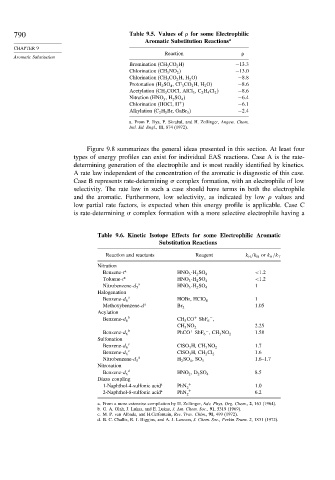Page 807 - Advanced Organic Chemistry Part A - Structure and Mechanisms, 5th ed (2007) - Carey _ Sundberg
P. 807
790 Table 9.5. Values of for some Electrophilic
Aromatic Substitution Reactions a
CHAPTER 9
Reaction
Aromatic Substitution
Bromination (CH 3 CO 2 H) −13 3
Chlorination (CH 3 NO 2 −13 0
Chlorination (CH 3 CO 2 H, H 2 O) −8 8
Protonation (H 2 SO 4 ,CF 3 CO 2 H, H 2 O) −8 6
Acetylation (CH 3 COCl, AlCl 3 ,C 2 H 4 Cl 2 −8 6
Nitration (HNO 3 ,H 2 SO 4 −6 4
Chlorination (HOCl, H −6 1
+
Alkylation (C 2 H 5 Br, GaBr 3 −2 4
a. From P. Rys, P. Skrabal, and H. Zollinger, Angew. Chem.
Intl. Ed. Engl., 11, 874 (1972).
Figure 9.8 summarizes the general ideas presented in this section. At least four
types of energy profiles can exist for individual EAS reactions. Case A is the rate-
determining generation of the electrophile and is most readily identified by kinetics.
A rate law independent of the concentration of the aromatic is diagnostic of this case.
Case B represents rate-determining complex formation, with an electrophile of low
selectivity. The rate law in such a case should have terms in both the electrophile
and the aromatic. Furthermore, low selectivity, as indicated by low values and
low partial rate factors, is expected when this energy profile is applicable. Case C
is rate-determining complex formation with a more selective electrophile having a
Table 9.6. Kinetic Isotope Effects for some Electrophilic Aromatic
Substitution Reactions
Reaction and reactants Reagent k H /k D or k H /k T
Nitration
Benzene-t a HNO 3 -H 2 SO 4 <1.2
Toluene-t a HNO 3 -H 2 SO 4 <1.2
a
Nitrobenzene-d 5 HNO 3 -H 2 SO 4 1
Halogenation
a
Benzene-d 6 HOBr, HClO 4 1
Methoxybenzene-d a Br 2 1.05
Acylation
b + −
Benzene-d 6 CH 3 CO SbF 6 ,
2.25
CH 3 NO 2
b + −
Benzene-d 6 PhCO SbF 6 ,CH 3 NO 2 1.58
Sulfonation
c
Benzene-d 6 ClSO 3 H, CH 3 NO 2 1.7
c
Benzene-d 6 ClSO 3 H, CH 2 Cl 2 1.6
a
Nitrobenzene-d 5 H 2 SO 4 ,SO 3 1.6–1.7
Nitrosation
d
Benzene-d 6 HNO 2 ,D 2 SO 4 8.5
Diazo coupling
1-Naphthol-4-sulfonic acid a PhN + 1.0
2
2-Naphthol-8-sulfonic acid a PhN + 6.2
2
a. From a more extensive compilation by H. Zollinger, Adv. Phys. Org. Chem., 2, 163 (1964).
b. G. A. Olah, J. Lukas, and E. Lukas, J. Am. Chem. Soc., 91, 5319 (1969).
c. M. P. van Albada, and H.Cerfontain, Rec. Trav. Chim., 91, 499 (1972).
d. B. C. Challis, R. J. Higgins, and A. J. Lawson, J. Chem. Soc., Perkin Trans. 2, 1831 (1972).

